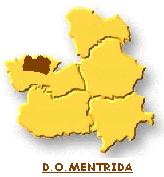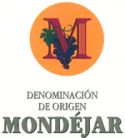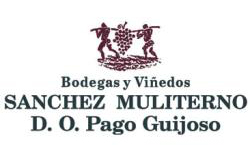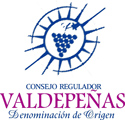Castile La Mancha DOs (Part II)
The vast plains of Castile, dotted with windmills, orchards and vineyards, are one of the typical Spanish landscapes. The climate here is similar to the one in the Mediterranean area, but temperatures tend to be much more extreme. This means really hot summers and very cold winters, where subzero temperatures aren't uncommon.
DO Méntrida

In the north of the Toledo close to Madrid province lies the DO Méntrida, established in 1976 and bathed by the Alberche river. The DO Méntrida was established in 1976, and its geography is mostly composed of plains with some mountains to the northeast, which are part of the San Vicente mountain range. The vineyards are planted at 1300-1900 feet of altitude and are affected by the continental climate, with very cold winters, very hot summers, and little rain. The Gredos mountains protect the fruits from the worst of the northern winds.
The Garnacha variety is the most used for the wines of La Mancha from DO Méntrida, but in the last years they have introduced other varieties like Tempranillo, Merlot, Syrah or Cabernet, which help to complete and balance the wines. Most of the production is reds and rosés with a high content of alcohol:
- Red wine, with a minimum alcohol content of 12%
- White wine, with a minimum alcohol content of 11%
- Rosé wine, with a minimum alcohol content of 11.5%
DO Mondéjar

The DO Mondéjar is in the southeast of the Guadalajara province, and two rivers pass through this DO on their way to the sea: the Tajo and the Tajuña. The vineyards are mostly planted at 2600 feet of altitude and enjoy a soft mediterranean climate with some continental influence and not much rain. They produce mostly reds, with some whites or rosés. The main grape varieties used are Malvar, Macabeo and Torrontés in whites; Cencibel and Cabernet Sauvignon for reds.
The alcohol levels in these wines of La Mancha are as follows:
- Red wine, with a minimum alcohol content of 11%
- White wine, with a minimum alcohol content of 10%
- Rosé wine, with a minimum alcohol content of 11%
DO Pago Guijoso

Like the DO Finca Élez, the DO Pago Guijoso started out as a private vineyard. In the province of Albacete bordering Ciudad Real is the farm El Guijoso, owned by the Sánchez Muliterno family since the beginning of the 90s. Their vineyards are planted at 3300 feet of altitude and the grapes used in production are Cabernet Sauvignon, Merlot, Syrah, Tempranillo, Chardonnay and Sauvignon Blanc. This is one of the few wineries which doesn't have a Spanish class of grape between its most used varieties.
The DO Pago Guijoso produces a wide variety of whites and reds by changing and mixing the different grape bases. This also helps to establish a base quality for all of the wines produced under the same DO. The types of wines from La Mancha and their alcohol content for the DO Pago Guijoso are as follows:
Reds:
- At least 50% Merlot with the rest composed by other red varieties, should have a minimum alcohol content between 12% and 15%
- At least 70% Cabernet Sauvignon with the rest composed by other red varieties, should have a minimum alcohol content between 12% and 15%
- At least 80% Syrah with the rest composed by Cabernet Sauvignon, should have a minimum alcohol content between 12% and 15%.
Whites:
- 100% Chardonnay, should have a minimum alcohol content of 12%-15%
- Chardonnay and a maximum of 15% of Sauvignon Blanc, should have a minimum alcohol content of 12%-15%
DO Ribera del Júcar

In the south of the Cuenca province is the DO Ribera del Júcar, established in 2003. The vineyards are mostly planted in plains around 2400 feet in altitude and they enjoy a warm mediterranean climate with a medium annual temperature of 14ºC with regular rains.
The allowed grape varieties are mostly red: Cencibel, Cabernet Sauvignon, Merlot, Syrah and Bobal. Nevertheless, in the later years they've started planting white grapes of the Moscatel de Grano Menudo and Sauvignon Blanc varieties. DO Ribera del Júcar produces reds, whites and rosés, but they classify their wines of La Mancha by aging:
- Young reds: No aging, alcohol content between 12% and 14.5%
- Tradición Júcar (Júcar Tradition): 4 months of aging in barrels of French or American oak and some aging in the bottle, alcohol content between 12% and 14.5%.
- Crianza: 24 months of aging in barrels of French or American oak, alcohol content between 12% and 14.5%
DO Uclés

West of the province of Cuenca and northeast of the province of Toledo, near Madrid, is the DO Uclés, established in 2003. This DO has its vineyards separated by the Altomira mountains right down the middle, and this results in some differences in the production. The vines in Cuenca are planted between 1600 and 2600 feet of altitude, while the vines in Toledo are planted higher, between 1900 and 3900 feet.
The DO Uclés is affected by a continental climate of extreme differences in temperatures between summer and winter, and little rain. They only produce red wines, using the varieties Tempranillo, Garnacha tinta, Cabernet Sauvignon, Merlot and Syrah. Their wines of La Mancha can be classified in 4 groups, all with a minimum alcohol content of 12%:
- Joven (young): No aging.
- Joven con barrica (young with barrel): They go through a short aging in oak barrels, never under 2 months. The time spent in the barrel should appear on the label.
- Crianza: Aging must never be less than 2 natural years after the grape harvest, with at least 6 months spent in oak barrels. They must finish their aging in the bottle.
- Reserva: Aging must never be less than 36 months after the grape harvest, with at least 12 months spent in oak barrels. They must finish their aging in the bottle.
DO Valdepeñas

The DO Valdepeñas has its vineyards in the south of the province of Ciudad Real, and it's affected by an extreme continental climate of really cold winters, really hot summers and very little rain. It's a very windy region, so the vines can't be planted very high, which is why they can all be found at approximately 2500 feet of altitude. This DO was established in 1932, making it a very experienced designation of origin and one of the oldest in Spain.
The DO Valdepeñas has both white and red grapes, and the varieties allowed are Airén, Macabeo, Chardonnay, Verdejo, Sauvignon Blanc and Moscatel de grano menudo in whites; Tempranillo, Garnacha, Cabernet Sauvignon, Merlot, Syrah y Petit Verdot in reds.
The alcohol levels in these wines of La Mancha are as follows:
- Red wine, with a minimum alcohol content between 11% and 14%
- Valdepeñas red, with a minimum alcohol content between 11% and 13%
- White wine, with a minimum alcohol content between 11% and 13%
- Rosé wine, with a minimum alcohol content between 10.5% and 13%
Spanish Wine History
Spanish Wine Regions and DO
Spanish Wine Tours
Top Spanish designations of origin
Best Spanish Wines
Spanish Wine Production
Spanish Wine Types
Spanish Grapes
Spanish Sparkling Wine: Cava
Sherry Wine
Spanish Wine Cocktails
Spanish Wines in the World
Spanish Wine Prizes
Enotourism
Spanish spirits and liquors
Argentina Wines
Chilean Wines
Other sites